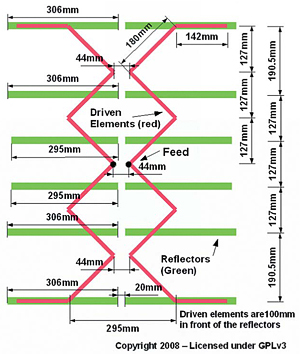TV Receive Antennas
Of all the columns I've written, the ones describing do-it-yourself antennas always bring the most response, sometimes years after the original column was written. This month I'll describe the "new" UHF receive antenna design that was released recently under the GNU Public License (www.gnu.org/licenses/gpl.txt). You shouldn't have to worry about infringing on someone's patent building this antenna. According to the Web site describing the antenna, www.digitalhome.ca/ota/superantenna/index.htm, Doyt R. Hoverman originally secured a patent in 1959 and 1964. Both patents have now expired. Radio Shack and AntennaCraft sold the antennas. There is a picture of one of these on the Web site.
User "Autofils" on the Canadian DTV discussion forum www.digitalhome.ca, shared his version of the Hoverman antenna and, with the help of computer modeling, improved it. The modified antenna, referred to as the Gray-Hoverman antenna, improves on the original design. Computer modeling shows, in a configuration similar to a 4-bay bow tie with reflector, it outperforms the bow-tie array. Stack two Gray-Hoverman antennas and the model shows better in-core UHF performance than the popular Channel Master 4228 8-bay bow-tie antenna.
The tradeoff is that the gain of the Gray-Hoverman antenna falls off rapidly at higher channels, and especially above Channel 54, where it has less gain than the 4228. At lower channels, however, the gain can be 2 dB or higher than the Channel Master antenna. Performance with a 4-bay Gray-Hoverman antenna is shown to beat the Channel Master 4-bay bow tie, model 4221, by a similar amount at some frequencies.
EASY TO BUILD

Fig. 1: Dimensions of a single-bay Gray-Hoverman antenna The plots for the Gray-Hoverman antenna show it having a somewhat broader main lobe with less side lobes and, if a screen type reflector is used, less of a back lobe than the bow-tie with reflector type antennas. The wider beam width also makes antenna aiming less critical.
In March, engineers were passing around the link to a video on YouTube describing how to make your own 4-bay bow-tie antenna from coat-hanger wire, www.youtube.com/watch?v=EWQhlmJTMzw. The Gray-Hoverman design should be easier to build, as there are no crossover phasing lines required and only two long wires are needed for the driven elements. As Fig. 1 shows, the antenna is very simple to construct. The Digital Home Web page www.digitalhome.ca/ota/superantenna/ has full details on the single bay and double bay antenna designs and pictures of finished antennas. If you are having difficulty reading Fig. 1, visit the Web site above or view, save or print a full-page color PDF plot from my Web site at www.xmtr.com/articles/RF182-fig1.pdf.
In the interest of precision, and to match the drawing on the superantenna Web site, dimensions are in millimeters. Conversion shouldn't be difficult as bends in the driven element are all spaced 127 mm, or 5 inches, apart. It should be noted that to achieve the best performance, the reflector elements are not connected in the center. There is a 20 mm (about 25/32) gap at the center of the antenna. Maintain the gap even if a screen type reflector is used to achieve the performance modeled on the Web site. The gap for the driven elements is 44 mm (about 1-23/32 inches). A high quality 300-ohm to 75-ohm balun/matching transformer should be connected to the two points marked "Feed" on the drawing. The two pairs of center reflector elements are shorter (295 mm or 11-5/8 inches) than the four pairs of 306 mm (12-1/16 inches) outer reflector elements. The spacing of the top and bottom reflector elements is greater than the spacing of the inner reflector elements—190.5 mm (7-1/2 inches) versus 127 mm (5 inches). The driven elements are spaced 100 mm (3-15/16 inches) from the screen or rod reflector elements.
BUILD IT BETTER
I'd appreciate hearing from readers who build this antenna. If you want to build the double-bay version, which the Web site shows outperforms the Channel Master 4228, simply space the bottom element of the top antenna and the top element of the bottom antenna 127 mm (5 inches) apart. Connect the two antennas with a phasing line 30 mm behind the reflector with the wires spaced 20 mm apart and fed in the center with a 300-ohm balun/matching transformer.
I hope to have a chance to build one of these antennas and give it a try. I'm intrigued by a design on the Digital Home Web site showing an antenna using fabric from a metalized "space blanket" as the reflector. If you can come up with a way to collapse the driven element (perhaps with hinges using ring lugs and screws or banana plugs and jacks perhaps), this could make a very interesting portable antenna. Add a few suction cups to hang it on the hotel room window and I'm sure it would work a lot better than the whip antenna I usually use. Of course, getting it through airport security might be an issue, unless you run into a ham or RF engineer working the security lines.
Don't laugh—I've had it happen to me twice. In Burbank, Calif., one inspector was a ham radio operator that was very interested in my assortment of electronics, especially my Kenwood TH-6A transceiver. Another, in Denver, was interested in the bag of RF adapters I was carrying, having worked with RF in the military.
PORTABLE DTV ANTENNAS
In my travels I've used a number of different portable DTV antennas. After carrying a battery-operated preamplified antenna around for a while, I settled on the nonmagnetic whip antenna and about 6 feet of miniature coax included with Hauppauge HVR-950. On my last trip, when I was testing out a new Artec T-18AR ATSC USB stick, I packed the flat postcard sized antenna (Artec AN-2) and suction cup mount that were included with it. This small antenna out-performed the whip antenna at both UHF and high VHF when I tested it in San Francisco. While the antenna was small for VHF, I believe the improved performance was due to it being a balanced antenna and not dependent on a ground plane, like the whip antenna.
Richard Swank, who maintains the KNTV transmitter for NBC in San Jose/San Francisco, alerted me to a new antenna from Artec—the AN-2A—which includes a USB powered preamplifier. The gain, with preamplifier, is specified as 14 dBi at UHF and 8 dBi at VHF. I haven't seen any of the Artec retailers selling this antenna. If I'm able to get ahold of one, I'll let you know how it works. It sounds like a winner! More information is available on the Artec Web site at www.artecdtv.com.
Next month, depending on how much there is to report from NAB, I'll have details on some new ATSC USB tuners and perhaps some tests of the Gray-Hoverman antenna.
Comments are always welcome. E-mail me at Dlung@transmitter.com. Please note that due to an e-mail client problem I lost many messages sent to my transmitter.com and xmtr.com e-mail addresses during the first three weeks of March. If you sent me an e-mail during that period and haven't received a reply, please resend it.
Get the TV Tech Newsletter
The professional video industry's #1 source for news, trends and product and tech information. Sign up below.

Doug Lung is one of America's foremost authorities on broadcast RF technology. As vice president of Broadcast Technology for NBCUniversal Local, H. Douglas Lung leads NBC and Telemundo-owned stations’ RF and transmission affairs, including microwave, radars, satellite uplinks, and FCC technical filings. Beginning his career in 1976 at KSCI in Los Angeles, Lung has nearly 50 years of experience in broadcast television engineering. Beginning in 1985, he led the engineering department for what was to become the Telemundo network and station group, assisting in the design, construction and installation of the company’s broadcast and cable facilities. Other projects include work on the launch of Hawaii’s first UHF TV station, the rollout and testing of the ATSC mobile-handheld standard, and software development related to the incentive auction TV spectrum repack. A longtime columnist for TV Technology, Doug is also a regular contributor to IEEE Broadcast Technology. He is the recipient of the 2023 NAB Television Engineering Award. He also received a Tech Leadership Award from TV Tech publisher Future plc in 2021 and is a member of the IEEE Broadcast Technology Society and the Society of Broadcast Engineers.
